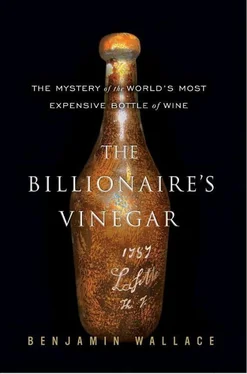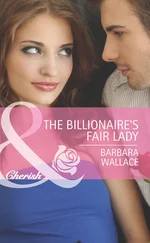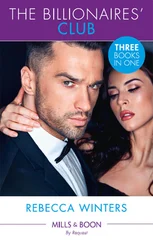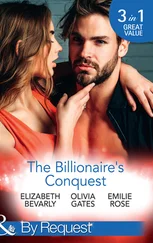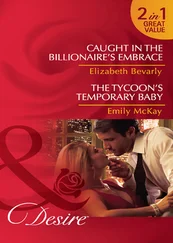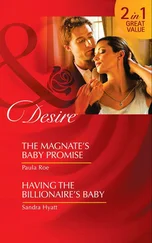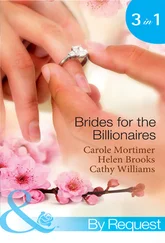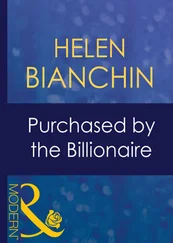The New Year came and went. On January 7, 1993, Broadbent eagerly wrote to Kip Forbes to reassure him. “Dear Kit,” his letter began, inauspiciously. “First of all, thank you for the charming family Christmas card. Always beautifully done.” Broadbent went on to say that the Zurich bottle had passed “with flying colors” and that “there is no reason to doubt that any of the Jefferson bottles which emanated directly from Hardy Rodenstock’s cellar have been tampered with.”
He also asserted that Cinder Stanton’s allegation that Jefferson never had his bottles engraved had been “disproved,” citing a September 17, 1789, letter from Jefferson to John Jay that Broadbent had discovered after the original furor in 1985. (Broadbent had since amassed a substantial Jefferson library.) In a postscript regarding a shipment of wine to George Washington, Jefferson had written, “Every bottle is marked (with a diamond) with the initial letter of the wine it contains.” Though the evidence related only to a single shipment of wine—a shipment to Washington rather than to himself, which included no red Bordeaux and only the generically described “Sauternes”—and mentioned only a one-initial engraving, Broadbent claimed vindication. One month later, in a letter to Margaret Kelly, the Forbes Galleries curator at the time of the original auction, Broadbent was more pointed. “The researchers at Monticello said that there was simply no evidence of Jefferson giving instructions for bottles to be identified by engraving,” Broadbent wrote. “How wrong they are.”
That spring, a lawyer for another owner of some Jefferson bottles, Bill Koch, expressed concern about the Frericks dispute. Koch’s office hired a Munich lawyer, Jack Schiffer, to look into it. Schiffer was satisfied by the evidence of the Bonani test, and Koch didn’t pursue the matter further.
On January 21, Rodenstock gloated to Foley, who was preparing a big article on the whole affair for Rarities, that the minister of research who had oversight of GSF, Hans Riesenhuber, had been fired two days earlier. Rodenstock suggested that the ouster was due to mistakes related to the Frericks test, including not charging Frericks for its cost. The following month, on February 15, Rodenstock wrote to Foley again. In this letter, Rodenstock set down a few further thoughts about Pétrus large-format bottles, the Jefferson-Yquem connection, and the recent Bonani/Hall tests, and he enclosed copies of friendly letters to him from Frericks sent as recently as the late 1980s. Only “jealousy and envy,” Rodenstock said, could have motivated Frericks to come forward with doubts years later. On February 23, Michael Broadbent wrote to Foley, including the 1789 Jefferson letter to John Jay mentioning diamond engraving, and concluded, “Let’s hope the whole subject can now be dropped.”
Rodenstock and Frericks tentatively agreed to a settlement in which they would stop denouncing one another and drop their respective legal claims, but Rodenstock couldn’t help himself. “Churchill always said that it is important who wins the last battle,” Rodenstock crowed. “As the experts have accepted, the wine can only be authentic. This has been proved by the exact and encompassing examinations in Oxford and Zurich. Whoever it was who poured new wine in the other bottle in an attempt to harm me, thank God he didn’t succeed.”
When Foley’s Rarities article came out, it included an entirely personal tangent about Frericks, describing him as a drunk and, quoting a German newspaper, “a flathead.” Frericks and Rodenstock wouldn’t reach a final settlement until 1995.

IN SPITE OF the scandal, Rodenstock claimed that his business had grown substantially from 1991 to 1992, and he continued to make the international wine scene. He was now often accompanied by Helga Lehner, a blond Munich actress he had married in 1991. In early 1994, Rodenstock and Georg Riedel hosted a blind tasting of French versus Napa wines, attended by twenty-four journalists, including Hugh Johnson, dean of English wine writers. The following year, in November, Rodenstock attended a lavish tasting in Ohio hosted by an ob-gyn who stored his 18,000-bottle collection in an underground bank vault he had bought and repurposed. And Rodenstock received two important new endorsements which suggested that the luster of his name had been at least partially restored by the tests in Zurich and at Oxford.
The first came from the Rothschilds, the first family of Bordeaux, whose name graced two of the five first growths. In 1994 the family acquired one of the Jefferson bottles to display at Waddesdon Manor, ancestral seat of an Anglo-Austrian branch of the dynasty and now a part-time tourist site overseen by Lord Jacob Rothschild and owned by England’s National Trust. The Waddesdon Wine Cellars were opening, and Michael Broadbent, who had kept the empty pint-sized bottle from the Bonani test at Christie’s on King Street, presented it to Lord Rothschild at London’s Spencer House on February 15. (Château Lafite itself donated a magnum of 1870, and Philippine de Rothschild, when she saw it, made a one-upping gift of 1868 Mouton.) The following week, Lord Rothschild sent a thank-you note to Rodenstock. The bottle took its place in a Lucite case in the cellar. A few years later, at the invitation of Lord Rothschild, Rodenstock and his wife would attend a lunch thrown at Waddesdon by Gordon Getty.
In 1995, Rodenstock executed his greatest public-relations coup yet, drawing Hugh Johnson and Robert Parker to his annual tasting. Johnson normally avoided such events (two years earlier, he had written witheringly about “the awe-inspiring vulgarity of some of America’s wine spectaculars”). Parker, though, was the real catch. He had, by this time, achieved an importance in the wine world unmatched by critics in other fields. It was hard for a retailer to sell a wine Parker didn’t like, and hard not to sell one he had praised. Though Parker was controversial—for his power over the market, for the largely European perception that he favored “obvious,” overconcentrated wines, for the silly precision of his 100-point scoring system—he was widely respected for his independence, integrity, and indifference to Bordeaux’s traditional hierarchy. He had launched his newsletter, The Wine Advocate, with Ralph Nader as his model, did not accept advertising, and, unlike many other wine writers, eschewed junkets and gift bottles.
Parker had some experience with old-wine collectors. It had been Bipin Desai who arranged for him to first taste Margaux 1900, which Parker then awarded 100 points in The Wine Advocate . But for the most part, Parker steered clear of mega-tastings, and he had declined several invitations to previous Rodenstock events. Eventually the two men were brought together by Daniel Oliveros and Jeff Sokolin, the Russian-born cousin of Bill Sokolin, for whom both men had worked before launching their own rarities business, Royal Wine Merchants. Among colleagues, Oliveros and Sokolin were known as “the sexy boys,” because they seemed to have an exclusive line on “sexy juice”—old bottles in large formats that nobody else offered. They were close to Parker, and they were believed to serve as Rodenstock’s distributors in America.
At some events in 1994 and 1995, Parker met Rodenstock and found, as he would later tell his newsletter subscribers, that “the unkind remarks I had read about him were untrue. A man of extraordinary charm and graciousness, Rodenstock is a true wine lover in the greatest sense of the word, as well as exceptionally knowledgeable, and generous to a fault (he charges nothing for the opportunity to participate in his tastings). His passion for wine history, and of course, the world’s greatest wines, is irrefutable.” Parker went on to say he had been persuaded to attend Rodenstock’s annual tasting in 1995 by three things: Rodenstock’s conviction that Pomerol had been given short shrift by the wine media, his “obsession with finding extraordinarily old bottles of Pomerol from private cellars in Europe,” and his sheer “passion and enthusiasm.”
Читать дальше
